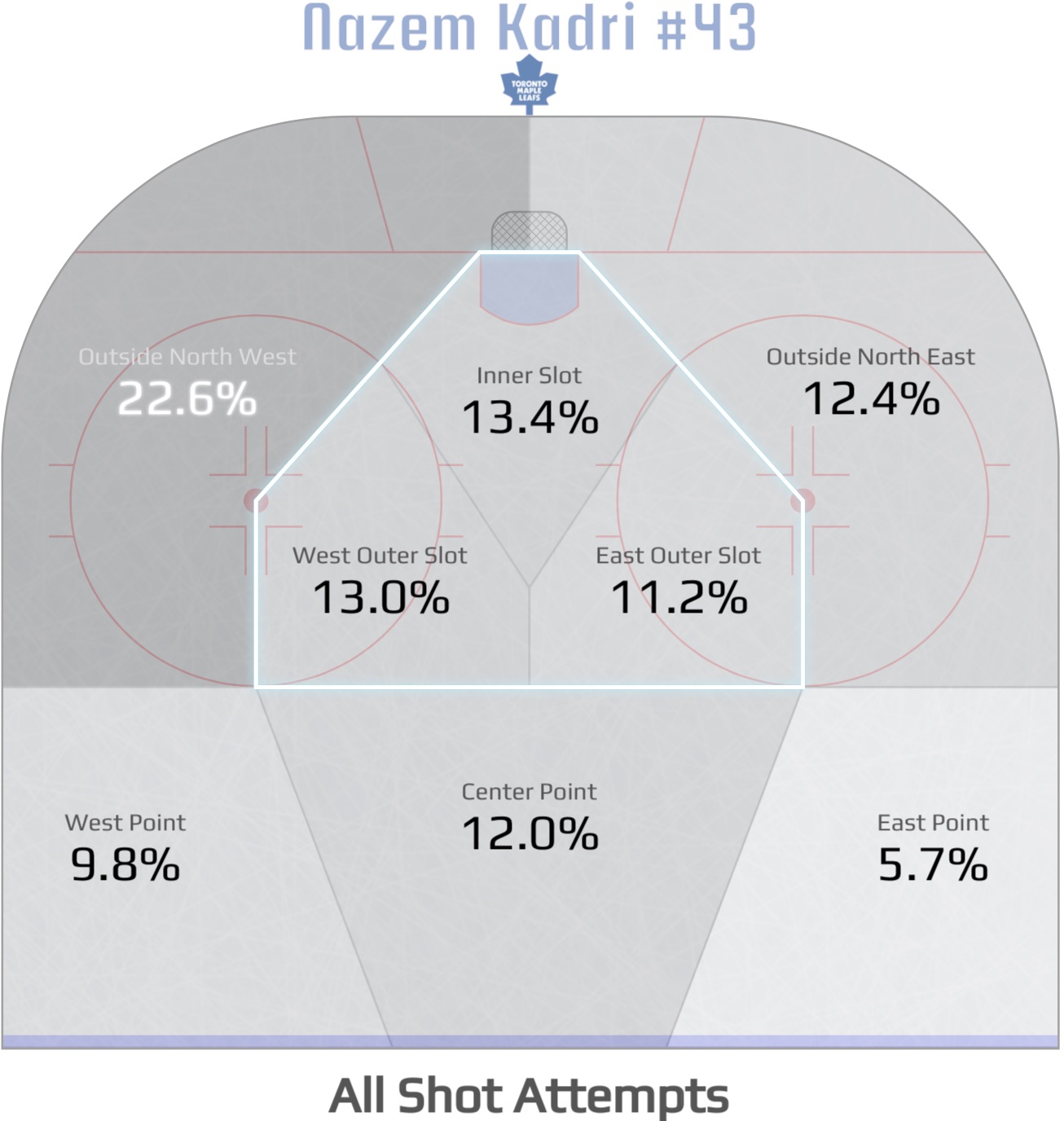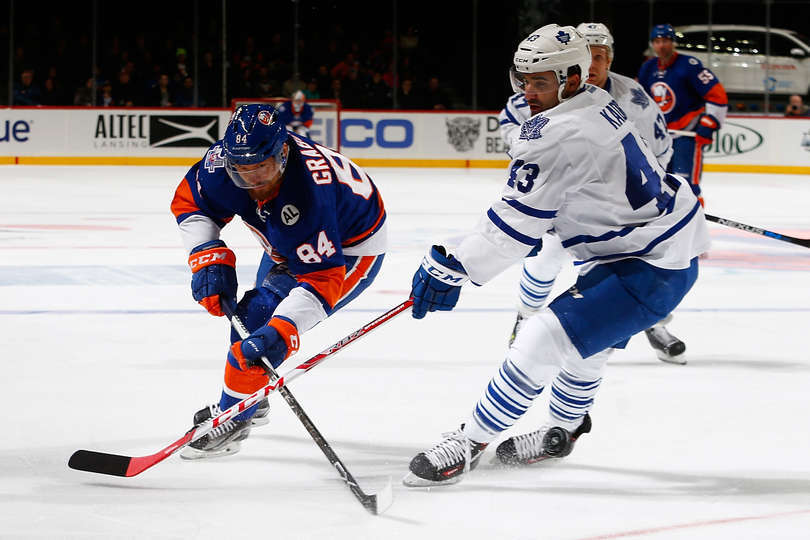Maple Leafs management has moved quickly to lock up Nazem Kadri as part of their core for the foreseeable future, inking the 25-year-old centerman to a six-year, $27 million pact on Wednesday.
It’s not altogether surprising if you took Lou Lamoriello and Mike Babcock at their word over and over and over again throughout the year. They painted the picture of a player who had bought into the Babcock program and was doing everything they asked of him this past season, from his work ethic to his competitiveness to improvements in his 200-foot game. Lou Lamoriello called him, “someone he’d go into a foxhole with.” Babcock has said a couple of times, “he’s done whatever I’ve asked.”
We were told to ignore all of this by fans and pundits who repeatedly made the comparisons between the effusive praise for Dion Phaneuf before his trade (the “pump and dump” scenario) and the kind words Babcock and Lamoriello have directed Kadri’s way. This ignored a couple of obvious key differences, one being that Dion Phaneuf is 31 years old and he had five years and $35 million remaining on his contract whereas Kadri was a 25-year-old soon-to-be RFA. Second, Lamoriello and Babcock’s compliments pertained often to Kadri’s on-ice play; that was almost never a part of the discussion about Phaneuf, who was mostly praised as a leader and a good person.
We now know Babcock and Lamoriello’s remarks were sincere as Kadri’s been locked down for six years with a limited no-trade clause. The Maple Leafs certainly weren’t in a position to not prioritize the expiring contract of a quality 25-year-old centerman heading into the offseason, but that the Leafs moved so quickly to lock him down long term before the outcomes of the draft lottery and Steven Stamkos’ future are known is seemingly a big vote of confidence in the player.
At the end of last season, there is no way Kadri thought he was a sure bet to remain in Toronto long term. Based on Shanahan’s words to the press after imposing a team suspension on Kadri for three games due to an off-ice issue, it’s doubtful Leafs management was sure of it, either. Full credit to Kadri, then, for winning over the skeptics — some within the fanbase and likely a few within his own organization.
https://twitter.com/generalfanager/status/720248594880528384
It goes without saying that Nazem Kadri has always been a lightning rod for polarized fan reception. Dating back to the reports (later denied) of $6 million contract demands in the summer of 2013, to his unwillingness to declare himself a worse player than John Tavares when asked about the comparison last season — shocking, coming from a confident professional athlete — there’s been the narrative out there that Kadri’s perception of his own abilities aren’t grounded in reality, and that it’s a serious problem for the Leafs. Does signing a long-term deal this reasonable so early in the offseason end all of that? Probably not, but it probably should.
Maple Leafs' Nazem Kadri tells HC@Noon he took a lower AAV in order to get the six years of term. Cites loyalty to team, fans in Toronto.
— luke fox (@lukefoxjukebox) April 13, 2016
My guess is Kadri’s camp wanted this type of deal a few years ago, but the Leafs — not without their reasons — didn’t want to commit long term just yet. It’s possible Kadri walked away from a long-term offer last summer, choosing to bet on himself after a down year. Either way, Leafs management saw enough growth from him on and off the ice this season to sign on the dotted line through to 2022.
Leafs management also likely benefited here from the suppressive effect their bad team had on Kadri’s numbers. As we’re all aware, Kadri’s production was a hot topic for discussion all year long (and really since 2013-14, after his near-point-a-game half-season lockout year didn’t translate over a full 82 games and he hovered in the same 45-50 point range over the three seasons since).
He played some good hockey out of the gate this year and put a tonne of rubber on net, only for the goals and points not to follow (Kadri ended up leading the Leafs in shots by more than 100 with 260). He started the season with just eight points in 20 games and two goals on 84 shots. Only toward the end of the season did the production start to rebound for Kadri, with eight points over his final six games prior to his season-ending suspension.
There is an argument to be made that the shot volume increase was due to Kadri throwing more junk on the net this season than years past. Andrew Berkshire put together this piece looking at the locations Kadri was generating his shot attempts from:

Berkshire then shows stark differences between where Tavares and Kadri generate their offense from.
Babcock has also told the media that Kadri’s shot is an area in need of improvement after his struggles to beat goaltenders clean this season, which is something that was pretty obvious to anyone watching. Admittedly, it’s a little bewildering if this is something Kadri is only now addressing in a serious way as he approaches his age-26 season.
All that said, it’s important to keep in mind that Kadri played mostly with Komarov and Grabner (most common linemates) in the toughest matchup every night. It seems fairly certain that his point totals will climb as more offensive talent is added around him (which happens instantly with JVR back healthy), and as he slots more naturally into the 2C role, assuming Nylander (with the Matthews and/or Stamkos possibilities looming) surpass him over time.
For perspective, Kadri played 400+ minutes at even strength with Michael Grabner, who was his second most common wing partner after Komarov. Grabner finished 242nd of 260 in even strength points among forwards to play 750+ minutes this season. In short, this was somewhat of a thankless role/deployment Kadri was operating under this season. He still maintained good possession numbers (1.9 CF% RELTM), but it no doubt impacted him offensively.
Even if you’re of the opinion that Kadri is perhaps not a top-six center on a contending roster, a $4.5 million investment in what is inarguably a good “tweener” center is still decent value for the team moving forward.
There seems to be a lack of sensible middle ground in the Kadri debate at times. His biggest defenders put him on a plane with Claude Giroux and Nicklas Backstrom based on possession and rate stats, while others don’t even view him as a capable top-six center. The beauty of this contract is that it doesn’t ask Kadri to be anything more than what he’s proven he can be — after all, it’s a modest $400,000 raise on his average annual cap hit. If Kadri continues to be a productive, play-driving 2/3 C for six years, the Leafs are getting good value here. And there’s plenty of reason to think Kadri has more to give offensively.
The Kadri & Rielly contracts are steals. Both are already worth their new AAV & may improve. Cap inflation matters. pic.twitter.com/NN1Gov24BX
— Zac Urback (@Zac_Urback) April 13, 2016
As Mike Babcock said, with another “NHL summer” — it’s fair to infer Kadri’s offseason training regimen wasn’t where it needed to be early in his career — Kadri may still take another step forward in his overall game.
The way the contract is structured also makes it a moveable one should Kadri fall by the wayside in Toronto over time as the Leafs add pieces:
#Leafs' Nazem Kadri will make $5M next season and 2017-18, $4.5M in 2018-19 and 2019-20 and $4M in 2020-21 and 2021-22.
— Stephen Whyno (@SWhyno) April 13, 2016
Nazem Kadri contract breakdown:
$3M salary/$2M signing bonus
$3M/$2M
$2.5M/$2M
$2.5M/$2M
$2M/$2M
$2M/$2M— Chris Johnston (@reporterchris) April 13, 2016
The run of good decision making continues for Brendan Shanahan, Lou Lamoriello and co.

































